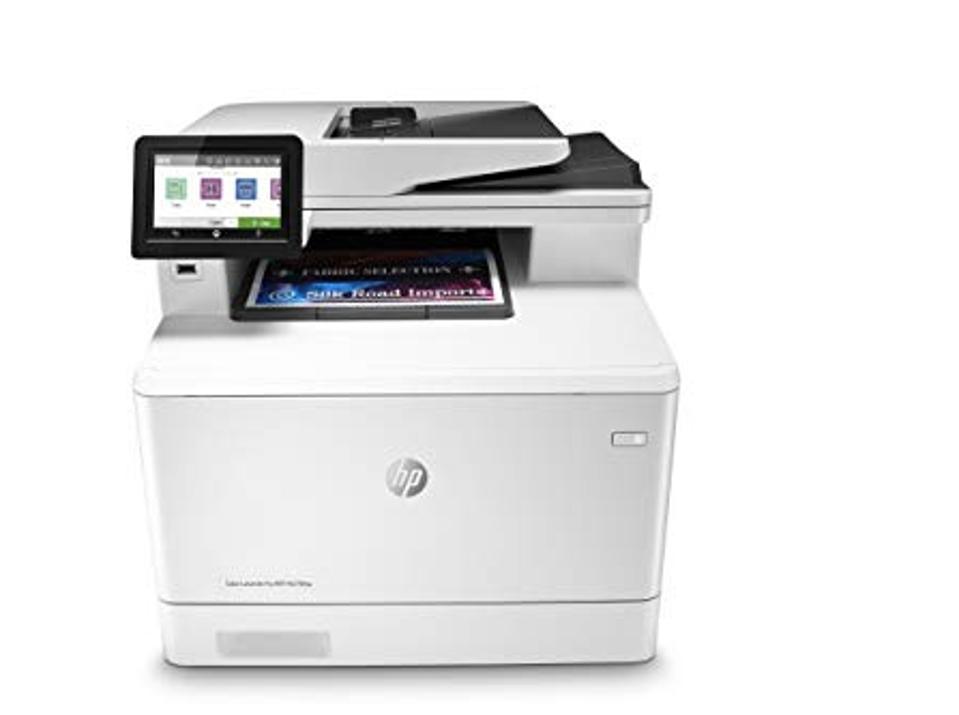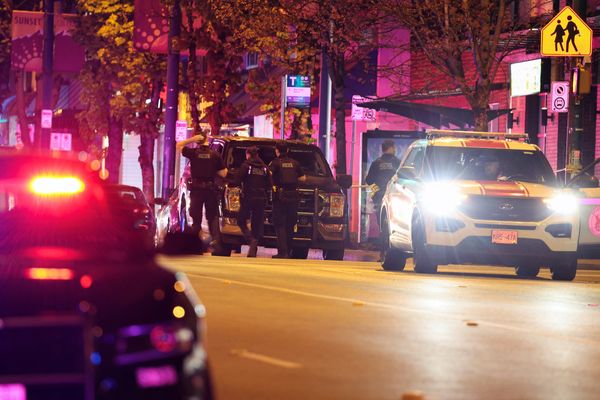An all-in-one printer (also known as multifunction or AIO) is designed to print, photocopy, scan and potentially serve as a fax machine, while taking up far less space than using three or four separate pieces of equipment. For a home, home office or small office setting, these have become the best printers to buy due to their affordability, size and convenience. And you have plenty of AIO printer options, from well-respected companies, like Canon, Epson, HP and Brother.

These days, the best all-in-one printers no longer rely on costly traditional ink cartridges. So, if you’re shopping for an inkjet printer in 2022, seek one that uses ink tanks (as opposed to ink cartridges). Each tank can typically hold the same amount of ink as between 20 and 30 individual ink cartridges. This will not only save you a fortune over time, but it’ll also eliminate the frustration of constantly having to swap out cartridges to replace ink.
In addition, the latest printers all offer wireless connectivity. This makes printing content directly from your smartphone, tablet or a computer a breeze. That said, AIO printers come in a vast range of sizes. What these devices can do, the print quality and print speed each offers, and how much they cost to buy and maintain vary greatly. Learn more with these 11 best AIO printers for 2022.
- Best All-In-One Printer: Canon Maxify GX7020
- Best Mid-Priced All-In-One Printer: Canon PIXMA MegaTank G3260A
- Best All-In-One Printer For Home Use: Brother MFC-L3750CDW Digital Color All-in-One Printer
- Best All-In-One Printer with Ink Tanks: HP Smart Tank 7301
- Best All-In-One Color Laser Printer: HP LaserJet Pro M479fdw
- Best Budget All-In-One Printer: Canon G3200
- Best Compact All-In-One Printer: Epson WorkForce WF-4740
- Best All-In-One Printer For Mobile Devices: HP Envy 7164 All-in-One Printer
- Best All-In-One Photo Printer: Canon PIXMA TR4520
- Best Portable All-In-One Printer: HP Tango X Smart Wireless Printer
- Best All-In-One Large Format Printer: Brother INKvestment Tank MFC-0J6945DW
Best All-In-One Printer
This Canon Printer Will Meet All Of Your High-Capacity Printing Needs
Best Mid-Priced All-In-One Printer
High-Volume Inkjet Printing Does Not Have To Be Costly
Best All-In-One Printer For Home Use
This Brother Printer Offers Plenty Of Versatility
Best All-In-One Printer With Ink Tanks
Avoid Needing Ink Cartridges In Your Home Office
Best All-In-One Color Laser Printer
This Color Laser Printer Will Meet The Needs Of Your Home Office
Best Budget All-In-One Printer
Save A Fortune By Not Constantly Having To Buy Ink Cartridges
Best Compact All-In-One Printer
This Epson Inkjet Printer Is A Budget-Friendly Option For Home Offices
Best All-In-One Printer For Mobile Devices
Priced Less Then $200, This HP Is Great For Wireless Printing
Best All-In-One Photo Printer
Here’s An Affordable Inkjet Printing Option From Canon
Best Portable All-In-One Printer
Meet Your Printing Needs On The Go With The HP Tango
Best All-In-One Large Format Printer
Print On Paper Up To 11 x 17 Inches Using This Brother Printer
What You Should Look For In An All-In-One Printer
If you’re looking at all-in-one printers, this means you’re seeking a single device that is capable of serving as a printer, copier, scanner and potentially a fax machine. You’ve probably noticed, however, there are a lot of options, and each offers a slightly different assortment of features, functions and specifications.
The first decision to make is whether you want an inkjet printer or laser printer. Each uses a different printing technology, with laser printers typically generating higher-quality and crisper printed documents. Inkjet printers, however, are much better at generating photo lab-quality prints from your digital images.
Laser printers are a good choice if you print a lot from a home office or have a large family with a lot of diverse printing needs. Monochrome laser printers (that have all-in-one functionality) are fast, reliable and inexpensive. They don’t do photos, however. You can invest in a color laser printer, but they're a lot pricier than their monochrome counterparts. If your printing needs sometimes include color, an inkjet printer with ink tanks is your least expensive option.
The print quality of a laser printer (versus an inkjet printer) tends to be superior, so for a home office from which you’ll be generating printed business correspondence or reports to be shared with others, a laser printer is likely more suitable. To meet the average needs of a family, however, an all-in-one inkjet printer will be more economical and versatile. Here are some other all-in-one printer-related features to consider:
- Duplex printing. Full duplex printers can automatically print to both sides of a page. Not everyone needs this, but if you’re printing long documents, this will save paper, so it’s better for the environment. Keep in mind, when printing on two sides of the page with an inkjet printer, you’ll likely want to use thicker (28 pound) paper, as opposed to traditional 20 pound multipurpose paper. This thicker paper will prevent the ink from bleeding through each page. This is particularly important if the document you’re printing contains graphics or photos that require a lot of ink.
- Print speed. Simply put, not all printers are speed demons. Many printers report two different speeds—the time it takes for the first print to slide out of the printer, and its PPM (pages per minute) speed. This is how long it takes to print each page once the printer has started printing. If you only print occasionally, print speed might not be that important, but it’s arguably the single most important feature if you print a lot. Also, despite what a printer manufacturer reports is a particular printer’s PPM speed, when you’re printing documents that are graphic intensive (or photos), the printing speed will always be slower. Even the fastest inkjet printers will take up to 90 second to print one 8.5 x 11 inch photo, for example.
- Connectivity. These days, most printers have wireless connectivity, so you can send files via Wi-Fi rather than plugging directly into the printer’s USB or Ethernet port. Some all-in-one printers allow for printing from memory cards (such as from your digital camera) or USB flash drives, and also support wireless printing standards, like AirPrint (for printing from your iMac, MacBook, iPhone or iPad). Many of the more modern AIOs also have the ability to print directly from cloud-based services, like Microsoft OneDrive, Google Drive or Dropbox.
- Photo printing. Any printer can spit out an image, but it won’t necessarily be something you’d want to hang on the wall. Some printers are optimized for photos with higher resolution or can handle over-sized printing. These often produce extra colors that do a better job reproducing photo-quality prints. In terms of making prints from your digital photos, some photo printers are better than others in terms of their resolution, especially when you use specialty inks (that won’t smudge or fade), in conjunction with premium photo paper.
- Copier Speed and Scanner Resolution - When you use an all-in-one printer as a copier or scanner, speed and resolution matter. You also want to determine if there’s a flatbed scanner (meaning pages to be scanned are inserted one at a time), or if the copier/scanner utilizes an auto sheet feeder for added convenience. In terms of resolution, higher is better, but for scanning black and white text-based documents, 300 dpi should be adequate.
- Ink Tanks Versus Ink Cartridges - Many of the latest inkjet printers now rely on high-capacity ink tanks, as opposed to individual ink cartridges. This is definitely a more economical option and eliminates the need of constantly having to swap out cartridges, as the ink tanks typically hold enough ink to last about two years.
- Laser Printer Cartridges: If you opt to go with a laser printer, a monochromatic laser printer’s toner cartridges tend to be inexpensive and will typically have a high-capacity option that’ll generate upwards of 10,000 to 12,000 pages before it needs replacing. If you buy generic toner cartridges for these printers, the cost will be under $50 each. However, toner cartridges for color laser printers continue to cost much more (upwards of $150 each) and generate far fewer pages. Plus, most color laser printers require multiple toner cartridges, so the ongoing cost to maintain a color laser printer is much higher than a color inkjet printer.
Which Printer Brand Is The Best?
As you might imagine, there’s no single best printer brand; collectively, several companies offer the best all-in-one printers of 2022. But depending upon what you’re looking for—affordability, high printing volume, photo and creative printing, or other criteria—you might prefer one brand over another.
Canon, Epson and HP—as well as a handful of other brands—all offer superb, all-in-one printer models that utilize either inkjet or laser printing technologies. If you're interested in office and productivity printing, HP and Brother are worthy of investigation, but if you want to make high-quality photo prints or get a multi-purpose printer than can do prints as well as other kinds of documents, Canon and Epson have a number of compelling choices.
Focus on your needs (not necessarily brand name) when seeking out an all-in-one printer that matches the functionality that’ll best meet your printing, copying and scanning requirements at a price you can afford.
What’s The Difference Between An All-In-One Printer And A Multifunction Printer?
In general, an all-in-one printer refers to a printer for home or home office use that can also serve as a photocopier, scanner, and perhaps as a fax machine. All of this functionality is built into one device that fits on a desktop and that can typically be used wirelessly from a computer, smartphone or tablet. (Most all-in-one printers also have an Ethernet and USB port for connectivity using a cable.)
A multifunction printer can also typically serve as a full-featured printer, scanner and photocopier. However, these devices are designed for use in an office setting. They tend to be larger, faster and more costly.
A multifunction printer typically gets connected to a company’s network, so it can be shared by a small group of people. These devices also tend to generate only black and white content, although some higher-end color laser printers and inkjet printers can also be labeled as multifunction printers because they’ll serve the needs of a small office or group of users on the same network.
Is A Dedicated Scanner Better Than A Printer Scanner?
Yes, but not always. A typical standalone scanner may offer higher resolution scanning capabilities and better color accuracy. This can be useful for scanning color documents with lots of graphics or photographs, for example. That said, there are plenty of all-in-one printers that include good quality scanners with a scanning resolution that rivals what a standalone scanner would offer.
If you’re willing to spend a bit for a standalone, flatbed or sheet-fed scanner, you won’t have trouble finding one that boasts an impressive 4800 x 4800 dpi or up to 6400 x 6400 dpi resolution. Some even offer up to 9600 x 9600 dpi resolution.
Meanwhile, what you’ll find built into a typical all-in-one printer will be a scanner capable of between 300 x 300 dpi and 1200 x 1200 dpi resolution. Obviously, the higher the resolution the better, especially if you'll be scanning photographs or documents with highly detailed graphics or illustrations. However, the higher the resolution you use, the larger the digital file size the scanned document will be.
Is An Inkjet Printer Or Laser Printer Better?
Well, that all depends on what you’re printing. For business documents, proposals, reports and correspondence, you’ll benefit from the sharper print quality and more professional appearance of content generated by a monochrome or color laser printer.
For creating photo prints from digital images, you’ll want to use either a dedicated inkjet photo printer or a mid- to high-end inkjet printer in conjunction with premium photo paper to achieve photo lab-quality results.
For general home use, just about any inkjet printer will work fine. However, you’ll save a lot of money over time if you choose an inkjet printer that uses ink tanks (as opposed to ink cartridges).
That said, if you’re using the two-sided printing feature of a lower-end inkjet printer, you may wind up needing to use thicker multipurpose paper, which is more costly. This will prevent the ink from bleeding through the page. These days, the print quality of some high-end inkjet printers rival what a laser printer is capable of, so which option you should choose will depend on how much you’re willing to spend on the printer.
Which Printers Have The Cheapest Ink?

For all their advantages, inkjet printers can be woefully expensive to maintain because name-band replacement ink cartridges are pricey. If low-cost ink is your overriding concern, consider an inkjet printer with ink tanks or a monochrome laser printer. Again, black laser toner is substantially less expensive than ink cartridges. (Color laser toner cartridges are much more expensive, however.) Replacement ink for inkjet printers that rely on ink tanks continues to be the most affordable (and environmentally friendly) option.
Among inkjet printers that rely on ink cartridges, consider printer models that store each color in its own cartridge. Printers which use combo cartridges are usually a lot more expensive to operate and maintain, because if you run out of any one color, you wind up needing to discard the entire cartridge along with any of its remaining ink. This is not an issue if the inkjet printer uses ink tanks instead of cartridges.
One problem with some inkjet printers is that the ink dries up on printheads and causes problems which need to be fixed by repeatedly running a printer head cleaning utility. For very sporadic printing needs, a monochrome laser printer may be your best option since it uses toner, which isn’t prone to drying out.
Consider Non-Genuine Ink And Toner Options
Keep in mind, there are independent companies, like LD Products, that manufacturer and sell inkjet and laser printer toner cartridges that are 100% compatible with name-brand printers, but they’re sold at a fraction of the price. You can also save money by subscribing to an ink cartridge replenishment service operated by your printer manufacturer.
What's The True Total Cost Of Owning A Printer?
The price you pay to purchase a printer is only the beginning. To keep the printer functional, you’ll need to keep it stocked with ink or toner, as well as paper. If it’s a laser printer, a separate drum unit will also need replacing periodically.
In general, 20-pound multipurpose paper will work with any printer. However, low-cost inkjet printers that offer two-sided printing will often benefit if you use thicker paper to prevent ink bleed through. When you use thicker paper, however, this reduces the capacity of the paper tray.
To calculate the cost per page to use any printer, take the cost for replacement ink/toner and divide it by the estimated page yield. For multipurpose paper, the per-sheet price is minimal, but using premium photo paper and generating high-resolution photo prints will boost ink usage and paper costs rather significantly.
So, if you’re looking to create photo prints from digital images, you’ll need to use premium photo paper. Depending on the paper size and the quantity you buy it in, this can get expensive. For occasional photo printing, you may be better off uploading your images to a one-hour photo lab. Using a printer to generate photo prints is more convenient, but the cost per print will typically be higher than what you’d pay a photo lab.
Especially if you see a printer with a very low up-front price, look carefully at the cost to replace the ink or toner. Some printer manufacturers charge less for their printers upfront, knowing they’ll generate long-term profits from high-priced ink or toner. As for the cost difference between color laser printers and inkjet printers, for people with high print volume needs, the higher maintenance cost of a color laser printer will be significant, but if your monthly print volume is minimal, you’ll get much higher print quality for your investment.


















